Biloxi Street Railway; Biloxi Electric Street Railway & Power Company
Biloxi Street Railway; Biloxi Electric Street Railway & Power Company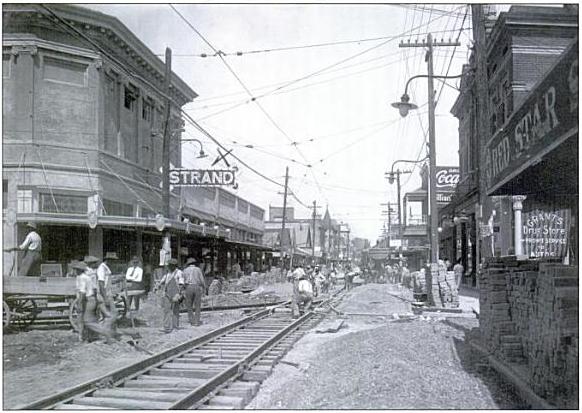
BILOXI CITY RAILWAY COMPANY
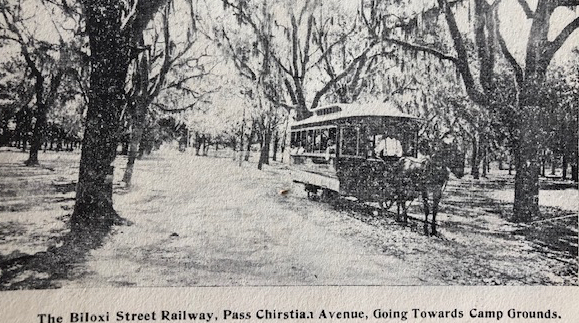
1895
The Biloxi City Railway Company was established in March 1895 by Dr. J.J. Lemon, president; J.C. Bradford, vice-pres.; Edward G. Burklin, general mgr. and superintendent; Col. EdwardW. Morrill [1939-1910], sec.-treas.; and W.H. Maybin, gen. attorney. Laying of track was to commence shortly as cars, rails, ties, etc. had been acquired. $8000 worth of company stock had been sold at $25 per share. Edward G. Burklin (1860-1931) had gone to NOLA and acquired at a heavy discount 15 rail cars, six miles of track, turn-tables, switches, and curves from the Prytania, Rampart, Dauphine Lines. The Biloxi City Railway ran from the L&N Depot south to Howard Avenue and east to Main Street. From Main Street south to the Beach and then to Point Cadet.(The Biloxi Herald, March 16, 1895, p. 8 and March 30, 30, 1895, p. 8)
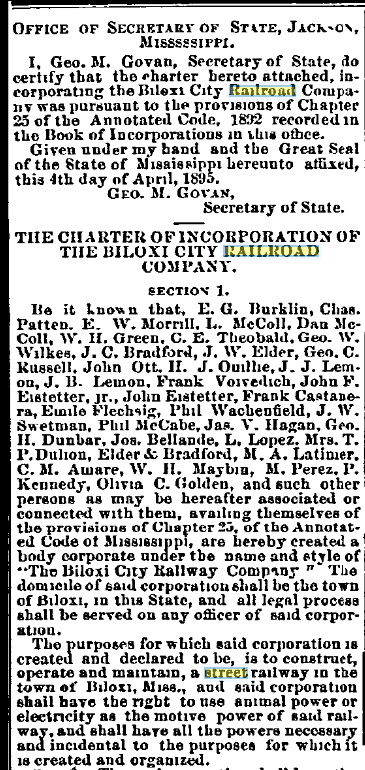
[The Biloxi Herald, April 20, 1895. p. 8]
Biloxi Electric Power Company
Biloxi became ‘electrified’ with the formation of the Biloxi Electric Power Company in 1894. It was chartered in the State of Mississippi on February 3, 1894 by a large contingent of Biloxi merchants, Coast seafood packers, and other prominent businessmen. Among them were: Edward G. Burklin (1860-1920+), Ed Glennan (1854-1933), J.W. Swetman (1863-1937), J.J. Lemon (1825-1915), E.J. Buck, Lazaro Lopez (1850-1903), Walter A. White (1854-1942), Harry T. Howard (1856-1930), Charles F. Theobald (1839-1903), John C. Bradford (1855-1928), Sherwood Bradford (1857-1937), Lyman Bradford (1863-1944), George E. Theobald (1873-1921), Francis B. Dunbar (1846-1908), George H. Dunbar (1844-1917), W.T. Bolton (1859-1923), S.B. Mayers, Frank Voivedich (1860-1930), John Eistetter, Isidore Heidenheim, Manuel Perez, John Bousquet (18-1908), Vincent Voivedich (1850-1927), Charles Patton (1839-1922), Casimir Harvey (1846-1905), John Johnson, Peter Eskald (1856-1944), T.A. Cleary, T.B. Cleary, C.M. Amare, Frank T. Howard (1855-1911), Nicholas Voivedich (1850-1937), J.W. Elder, Charles Redding, A. Bousquet, Lizzie Bradford, and W.K.M. Dukate (1852-1916). The first Board of Directors of the Biloxi Electric Power Company was composed of the following: Edward G. Burklin, Ed Glennan, J.J. Lemon, Lazaro Lopez, J.W. Swetman, E.J. Buck, and Walter A. White.(Harrison Co., Mississippi Chattel Deed Bk. 2, p. 116)
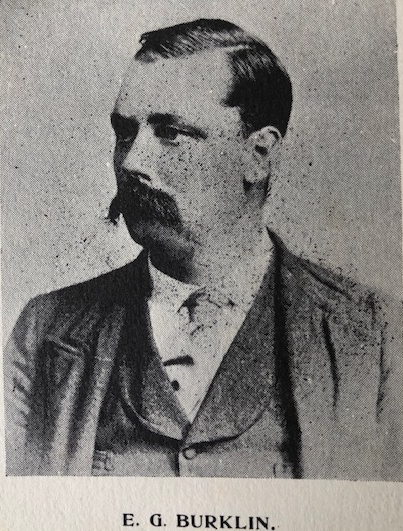
Edward G. Burklin
Edward G. Burklin (1860-1931) was born at Vandalia, Missouri. He came to Biloxi in the fall of 1892 with the purpose of building a flour mill and an electric light plant near the L&N Depot. He had erected several flour mills in Missouri. Mr. Burklin returned to Missouri and expired at Carthage, Jasper County, Missouri on June 3, 1931. At Biloxi, Mr. Burklin founded the light and power plant, first street railway [horse drawn], and telephone system.(The Biloxi Herald, November 5, 1892, p. 4)
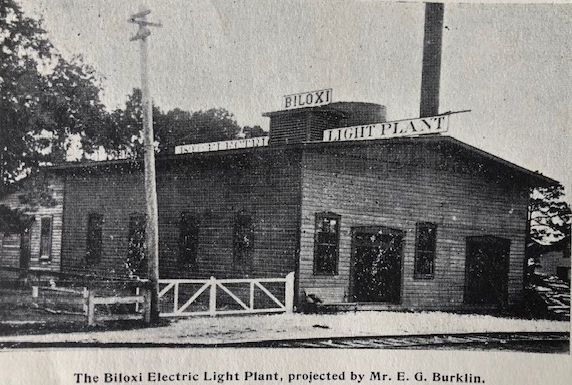
[from Along The Gulf, Dye, 1895]
In April 1893, the Biloxi Milling Company, commenced operations making flour and meal. It was founded by Missourians, Edward G. Burklin (1860-1931), James B. 'Buck' Chinn (1857-1912), R.D. Chinn, and Mr. Brewton. The mill was situated on the northeast corner of Magnolia Street immediately north of the L&N Railroad tracks.(The Biloxi Herald, January 7, 1893, p. 8 and April 22, 1893, p. 1)
1902
Incorporation
The Biloxi Electric Street Railway and Power Company was chartered in the State of Mississippi on
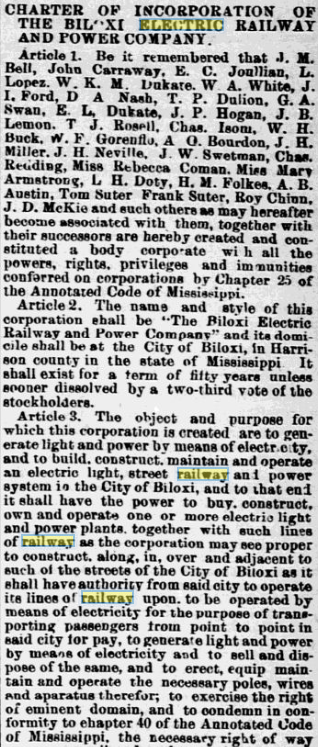
[The Biloxi Herald, December 6, 1902, p. 3]
The City of Biloxi gave the Biloxi Electric Railroad and Power Company led by W.K.M. Dukate the right to build a railway on Reynoir Street from the L&N RR to Howard Avenue and from Howard Avenue east to Main Street. This privilege had been granted to E.C. Jouillian (1864-1931) in August 1902.(Harrison Co., Ms. Land Deed Bk. 67, p. 247)
1903
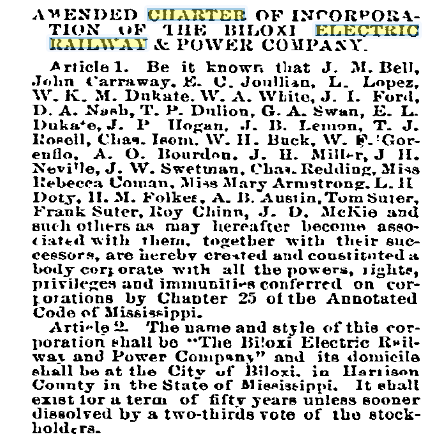
[The Biloxi Daily Herald, March 14, 1903, p. 8]
In early July, the Biloxi Electric Street Railway and Power Company contracted to acquire 300,000 bricks from the Biloxi Brick Company to erect their power house on Lameuse Street. The brick company agreed to deliver 75,000 brick immediately with the remainder to arrive within thirty days. The bricks cost $8 per one thousand. It was anticipated that the power house construction would start in ten days. Also at this time, six miles of trolley wire and the large steam domes of the big boilers arrived.(The Biloxi Daily Herald, July 3, 1903, p. 6)
The City of Biloxi signed a new eighteen month contract with the Biloxi Electric Street Railway to furnish free city lights.(The Biloxi Daily Herald, July 8, 1903, p. 5)
Two more car loads of boiler fixtures for the power plant have arrived.(The Biloxi Daily Herald, July 8, 1903, p. 5)
The Biloxi Electric Power Company was acquired by the Biloxi Electric Street Railway Power Company. The transaction was enacted for $29,500 in cash and $18,000 in stock.(The Biloxi Herald, Novemebr 4, 1903, p.6)
By early September crews were working feverishly on Point Cadet in east Biloxi. Track was being laid on Oak Street from East Howard Avenue to the beach and grading was almost completed from Oak Street east to the Barataria Canning Company. Archille Chiapella (1862-1936) who resided on the east side of Reynoir Street between Howard Avenue and the L&N Railroad was demanding the Biloxi Electric Street Railway Company place their tracks in the center of the street when it fronted his property. Chiapella’s request was redundant as the company preferred to locate their tracks in the street’s center. In addition, the street railway company had no control of where the tracks were placed on the street as the alderman of each ward in the city had this power.(The Biloxi Daily Herald, September 3, 1903, p. 6)
The stock holders of the Biloxi Electric Light Company sued the directors of the company for $4166.67, the pro rata, due to the holders of 25 shares of stock, from the Biloxi Electric Street Railway Power Company.(The Biloxi Daily Herald, September 4, 1903, p. 6)
The fountain situated at Lameuse Street and Howard Avenue had to be relocated to Lameuse Street and Front Street in order that the electric railway could pass unimpeded. Martin Hass, the City Plumber, was in charge of the project. Following the large conflagration of 1889, Harry T. Howard (1856-1930), philanthropist, donated an artesian well and fountain to the City at this location to provide a ready source of water for drinking and fire purposes.(The Biloxi Daily Herald, September 9, 1903, p. 6)
October 1903
The work of grading Lameuse Street for the electric railroad from Howard Avenue from the Montross Hotel was commenced on October 13, 1903. Contractor O’Beirne is building the transportation route.(The Biloxi Daily Herald, October 13, 1903, p. 8 and October 19, 1903, p. 8)
Route
The Biloxi Electric Street Railway ran from the western corporate limits of Biloxi on Front Street, now West Beach Boulevard, to Porter Avenue. Here the tracks turned north onto Porter and went to Howard Avenue where the line ran east along Howard Avenue to Oak Street. The railway went south on Oak Street to Front Street and then east on Front Street to Cadet Street, near the Barataria Canning Company. A spur also ran north from Howard Avenue on Oak Street to the L&N Railroad. Another short route from Howard Avenue connected the Biloxi Electric Street Railway with Front Street from Lameuse Street. The Back Bay section of Biloxi was reached by the line from Howard Avenue and Reynoir going north to Back Bay and then east to the factory of E.C. Joullian, which was on Back Bay near Main Street.(Harrison Co., Mississippi Land Deed Bk. 104, pp. 104-105)

Gulfport and Mississippi Coast Traction Company-1905
The Biloxi Electric Street Railway & Power Company was acquired by Joseph T. Jones and the Gulfport and Mississippi Coast Traction Company for $1 million on 15 September 1905. The conveyance included the following: the Biloxi street railway and franchise; Biloxi electric street contract; electirc plant at Biloxi and Ocean Springs; and desire to extned the railway to Gulfport and beyond.(The Biloxi Herald, July 7, 1905, p. 1 and Harrison Co., Mississippi Land Deed Bk. 70, p. 109)
1924
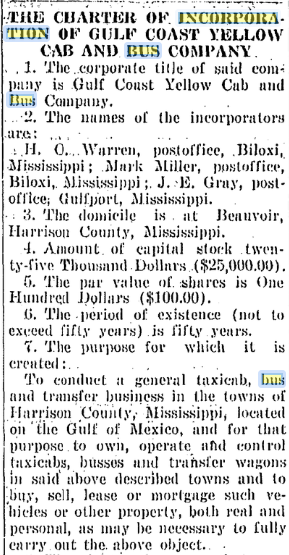
[The Daily Herald, June 12, 1924, p. 2]
Mississippi Power Company-1924
The Mississippi Power Company was organized when it acquired the Gulfport and Mississippi Coast Traction Company on December 31, 1924. J.M. Barry, president and Frank N. Savage, assistant secretary. [also reported ] The Gulfport and Mississippi Coast Traction Company was acquired by the Mississippi Power Company in late December.(Harrison County, Mississippi Land Deed Bk. 151, p. 340 and The Daily Herald, December 29, 1924, p. 1)
1926
In early January, Barney E. Eaton [1878-1944] of the Mississippi Power Company related that street car service between Gulfport and Long Beach had been replaced by motor coaches and that the company had invested about $200,000 in buses and ancillary equipment.[The Daily Herald, January 2, 1926, p. 1]
In March 1926, the Mississippi Power Company announced that a hydro-electric line paralleling the Coast would be included in its $70 million development plan. The companies hydro-electric plants were situated on the Coosa and Tallapoosa Rivers in Alabama and a 110,000 volt line would be built from the Alabama-Mississippi state line to a step-down transformer station at Gulfport. Permission had been granted to the company to construct power lines on the bridge across the Back Bay of Biloxi from D’Iberville.(The Biloxi News, March 28, 1926, p. 1)
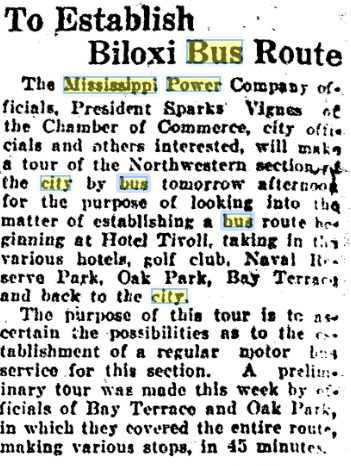
[The Daily Herald, December 1, 1926, p. 2]
1927
John Donzelli [1888-1950], native of Sicily, and spouse Mabel Roberts [1900-1982], born in Wisconsin, operated the Golden Fawn Bus Line for several years at Gulfport. They were victims of the Depression and lost their Gulfport home and in 1929 relocated to Indianapolis where John cleaned busses for Greyhound. Lucy,a daughter, was born at Gulfport in August 1927.
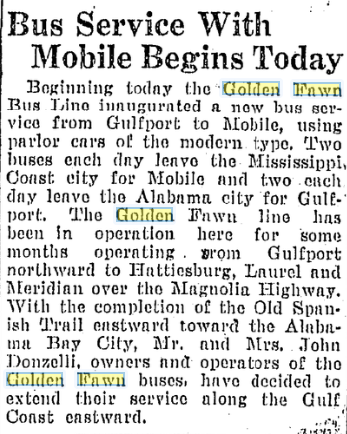
[The Daily Herald, April 12, 1927, p. 3]
The Teche Transfer Company was given the priviledge of transporting passengers by bus from New Orleans to the Coast with stops at Bay St. Louis, Pass Christian and Biloxi. Teche was not permitted to pick up local passengers, which were provided transportation by the City Bus Company between Pass Christian and Biloxi.[The Daily Herald, October 13, 1927, p. 7]
1932
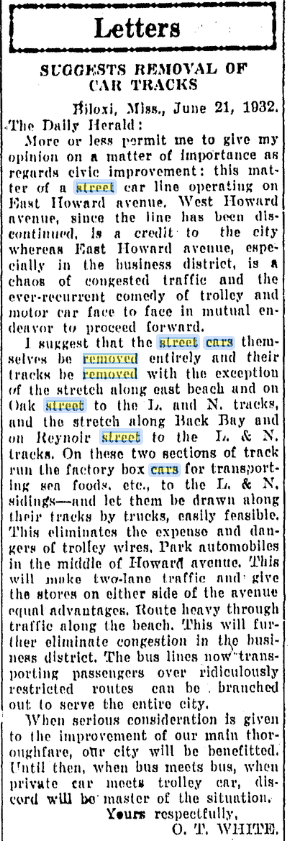
[The Daily Herald, June 22, 1932, p. 8]

[The Daily Herald, September 26, 1932, p. 1]
1936
The ICC reported in October 1936, Gulfport and Mississippi Coast Traction Company had accrued a deficit of $366,688. Total investment in the road and equipment was $390, 686.(The Daily Herald, October 1, 1936, p. 1)
1944
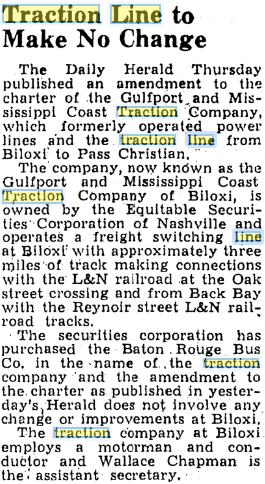
[The Daily Herald, December 13, 1944]
1949
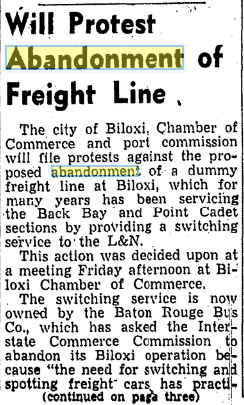

[The Daily Herald, January 15, 1949, p. 1]

[The Daily Herald, June 8, 1949, p. 9]
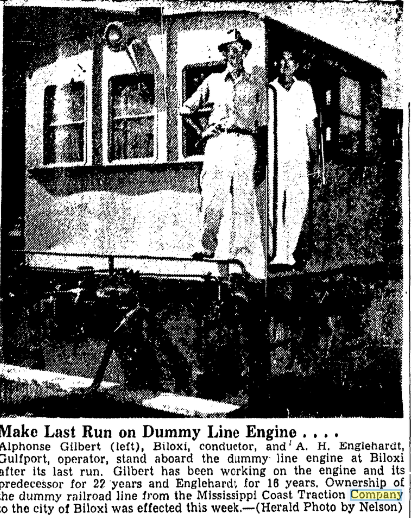
[The Daily Herald, August 30, 1949, p. 1]

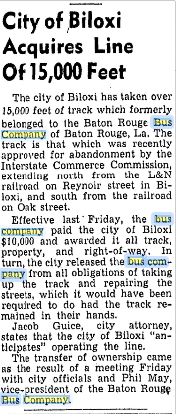
[The Daily Herald, August 30, 1949, p. 1]
REFERENCES:
The Biloxi Herald, “Electric Lights”, November 5, 1892.
The Biloxi Herald, “Local Happenings”, January 7, 1893, p. 8
The Biloxi Herald, “Local Happenings”, April 22, 1893, p. 1
The Biloxi Herald, “Lights for the town”, September 30, 1893.
The Biloxi Herald, “Progressive Biloxi”, March 16, 1895.
The Biloxi Herald, “The City Railroad”, March 30, 1895.
The Biloxi Herald, “Charter of Incorporation of the Biloxi City Railroad Company”, April 20, 1895.
The Biloxi Daily Herald, “Stock taken”, November 15, 1902.
TThe Biloxi Daily Herald, “The Charter”, December 18, 1902.
The Biloxi Daily Herald, “Electric Street Railway”, January 16, 1903.
The Biloxi Daily Herald, “Biloxi Electric Railway Company”, February 24, 1903.
The Biloxi Daily Herald, “Damage suit”, June 17, 1903.
The Biloxi Daily Herald, “Big Brick deal”, July 3, 1903.
The Biloxi Daily Herald, “Biloxi for Biloxians”, July 3, 1903.
The Biloxi Daily Herald, “Biloxi for Biloxians”, July 6, 1903.
The Biloxi Daily Herald, “City Fathers”, July 8, 1903.
The Biloxi Daily Herald, “Biloxi for Biloxians”, July 9, 1903.
The Biloxi Daily Herald, “The silver spike”, August 13, 1903.
The Biloxi Daily Herald, “City News”, September 3, 1903.
The Biloxi Daily Herald, “Want a receiver”, September 4, 1903.
The Biloxi Daily Herald, “Fountain to be moved”, September 9, 1903.
The Biloxi Daily Herald, “City Items”, October 13, 1903.
The Biloxi Daily Herald, “City Items”, October 19, 1903.
The Biloxi Daily Herald, “Deal closed”, November 4, 1903
The Biloxi Daily Herald, “Let us have an electric line to Biloxi”, November 25, 1903.
The Biloxi Daily Herald, “The cars”, December 15, 1903.
The Biloxi Daily Herald, “Money makers”, March 25, 1904.
The Biloxi Daily Herald, “Work on Coast railway to begin”, July 4, 1905.
The Biloxi Daily Herald, “Electric plant sold to Jones" July 7, 1905.
The Daily Herald, “Biloxi promoter [E.G. Burklin] of 1893 writes”, October 4, 1919.
The Daily Herald, “Eaton makes statement”, January 2, 1926.
The Daily Herald, “Tech [sic] Bus Line will not take up Coast passengers”, October 13, 1927.
The Daily News, “Power line to Coast included in companies program”, March 28, 1926.
- 1590 views
Newspapers
Newspapers ray Mon, 12/30/2013 - 10:28
EDITORS TIME LINE
1911
William E. Champlin [1866-1911]
The Mentor and The Biloxi Banner
1914
Pizarro K. Mayers [1833-1914]
The Handsboro Democrat and The Pascagoula Democrat-Star

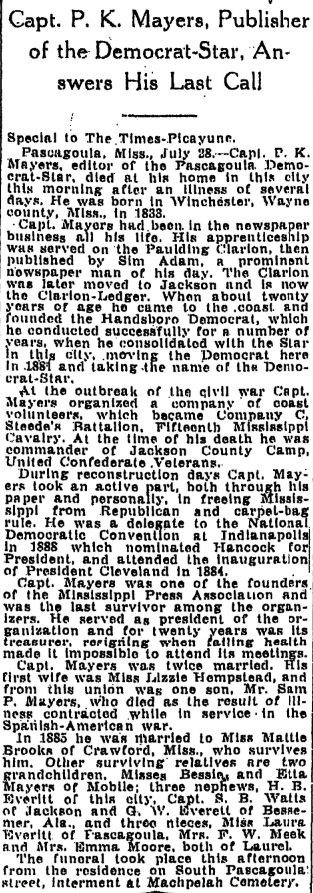
[The Times-Picayune, July 29, 1914, p. 16]
1915
George W. Wilkes
The Pascagoula Democrat-Star, The Biloxi Herald, The Biloxi Daily Herald, The Daily Herald
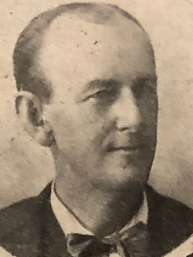
George Washington Wilkes [1854-1915], native of Indiana, died 29 March 1915 at Biloxi. He had survived, murder of a fellow editor; major Biloxi conflagrations; multiple office relocations; and several hurricanes, had left his newspaper in the capable stewardship of his widow and children. He had opened a Gulfport office in 1911 and was printing his newspaper there as well. Son, Eugene ‘Gene’ P. Wilkes, would lead The Daily Herald until it was sold in July 1968 to the State-Record Company of Columbia, South Carolina.[The Daily Herald, August 24, 1911; July 10, 1968; and October 15, 1973, p. 14]
The Pascagoula Democrat-Star
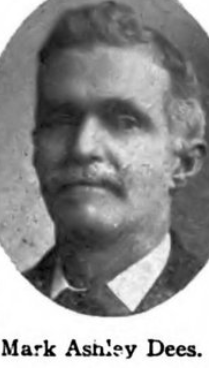
M.A. [Mark Ashley] Dees [1840-1915], native of Cottage Hill, Alabama expired at Dayton, Ohio on 7 June 1915. He had been an owner of The Pascagoula Democrat-Star, entrpreneur, inventor, and State Representaive from Jackson County.[The Daily Herald, June 10, 1915, p. 2]
John A. Osoinach
1951
George P. Money
The Daily Herald
George Pierson Money (1867-1951), the elder brother of H.D. Money, was born in Hinds County, Mississippi. Like his brother, George P. Money was a lawyer having studied for the bar examination in Carrollton, Mississippi. In 1891, he was admitted to the bar there and practiced law for twenty-five years. When his father was in the Senate, young Money resided in Washington D.C. and worked as a file clerk in the House of Representatives document room and was chief clerk in the folding room of the House of Representatives. He also worked on a USGS survey team, which was mapping the region near the District of Columbia.(The Daily Herald, March 7, 1951, p. 1)
George P. Money’s law experience was quite varied. From 1893 to 1900, he worked as the assistant U.S. attorney for the Territory of New Mexico. In November 1904, he ran unsuccessfully as a Democrat for the position of delegate to Congress from the New Mexico Territory. In 1905, the G.P. Money family relocated to the Mississippi Gulf Coast. He was the deputy clerk and U.S. commissioner at Biloxi from 1918 until 1949.(The Daily Herald, June 3, 1948, p. 6 and March 7, 1951, p. 1)
At heart, George P. Money was a newspaperman. His early experience was with The Chattanooga Evening News and The Greenwood Enterprise, where he co-published with Governor James K. Vardaman (1861-1930). During WW I, Money became associated with The Daily Herald. He was with this journal for thirty-two years and was its longtime editor.(ibid.)
BILOXI NEWSPAPERS
The Seashore Sentinel-The Biloxi Sentinel
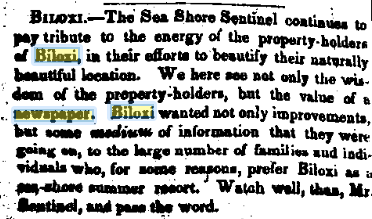
[The Daily Picayune, April 2, 1851, p. 3]
______________________________________
The Biloxi Mirror
August 1875-November 1876
1875-1876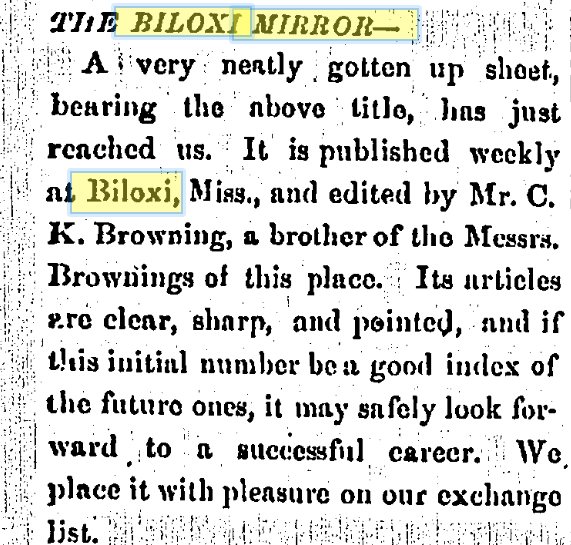
[The Orangeburg News and Times [South Carolina], August 14, 1875, p. 4]

[The New Orleans Republican, November 5, 1876, p. 5]
REFERERNCES:
The Daily Herald 50th Golden Jubilee Number Biographical and Historical 1884-1934, (The Daily Herald: Gulfport-Biloxi, Mississippi-1934).
Twentieth Century Coast Edition of the Biloxi Daily Herald: Historical and Biographical(George W. Wilkes & Sons: Biloxi-1902).
____________________________________
1884
The Biloxi Herald
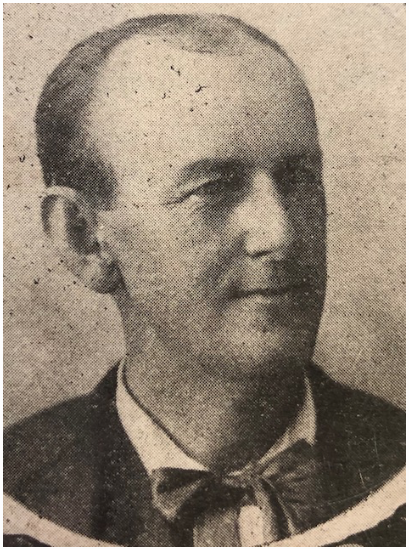
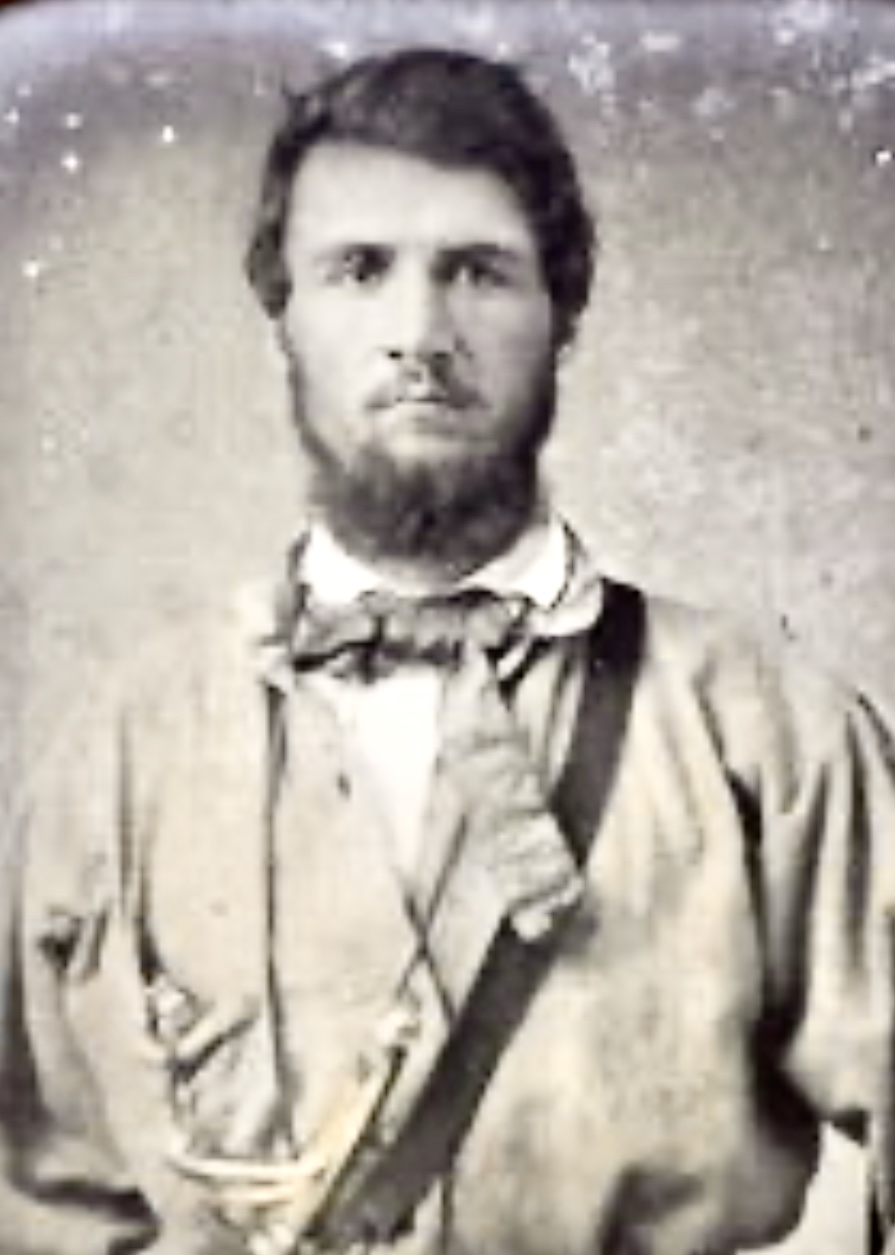
G.W. Wilkes M.B.Richmond
George Washington Wilkes [1854-1915] and Marion Berry Richmond [1846-1930], a veteran of the Siege of Vicksburg and Wilkes’ partner at The Pascagoula Democrat-Star, relocated to Biloxi from Pascagoula in 1884 and commenced a new weekly journal, The Biloxi Herald. By 1898, Wilkes was the sole proprietor of the paper and on August 16, 1898, printed his first daily issue, The Biloxi Daily Herald.[The Daily Picayune, September 6, 1884, p. 2 and The Biloxi Daily Herald, August 16, 1898, p. 1]
Before his 20th year, G.W. Wilkes was engaged in printing in the Hoosier State. He came South and was a resident of Pascagoula as early as January 1877. He advertised as representing The New Orleans Times where at his office the latest telegraphic news could be acquired for a nickel.[1870 Gibson Co., Indiana Federal Census R M593_316, p. 305A and The Pascagoula Democrat-Star, January 12, 1877, p. 5]
Anecdotal history relates that he had been domiciled at New Orleans prior to relocating to the Gulf Coast. It is known that his sister, Ada Jane Wilkes Klocke [1859-1878], wife of Gustave A. Klocke [1860-1908], former printer for The Daily Picayune, expired in the Crescent City on 16 October from Yellow Fever.[The Pascagoula Democrat-Star, October 18, 1878, p. 4 and The Daily Picayune, July 26, 1908, p. 4]
Before G.W. Wilkes embarked in the newspaper and printing business at Pascagoula, he was the proprietor of a clothing store. This was short lived as in September 1881, he and Marion B. Richmond acquired one-half interest in The Pascagoula Democrat-Star from M.A. Dees. Captain P.K. Mayers, their partner, remained a business manager of the journal.[The Pascagoula Democrat-Star, March 25, 1881, p. 3 and September 30, 1881, p. 3
Realtor

[The Biloxi Herald, August 14, 1897, p. 5]
By the time of his demise on 29 March 1915, George Washington Wilkes, who had survived, murder of a fellow editor; major Biloxi conflagrations; multiple office relocations; and several hurricanes, had left his newspaper in the capable stewardship of his widow and children. He had opened a Gulfport office in 1911 and was printing his newspaper there as well. Son, Eugene ‘Gene’ P. Wilkes, would lead The Daily Herald until it was sold in July 1968 to the State-Record Company of Columbia, South Carolina.[The Daily Herald, August 24, 1911; July 10, 1968; and October 15, 1973, p. 14]
Under the aegis of Roland Weeks Jr. who became president of Gulf Publishing, a State-Record subsidiary, The Daily Herald continued to prosper. Today, the printed word has reached a nadir not ever seen in American journalism. Contributing factors are television, social media, aging Baby Boomers [who can read], apathetic Generation X and Millennials, and the recent advent of ‘fake news’. What’s in your information repertoire?
1891
The Biloxi Herald moved into its new office building adjacent to the Masonic Opera House on Pass Christian Street about April 15, 1891. The structure was built by John R. Harkness and was central and desirable than their last quarters.(The Biloxi Herald, April 4, 1891, p. 4)
THE BILOXI HERALD
$2.00 Per Year
OFFICIAL JOURNAL OF HARRISON COUNTY.
OFFICIAL JOURNAL OF TOWN OF BILOXI.
OFFICIAL JOURNAL OF HARRISON CO. FARMERS’ ALLIANCE.
George W. Wilkes, Publisher
(T.H. Glenn, 1893, advertisement)
1896
Captain John H. Miller (1847-1928) assumed editorial control of The Biloxi Herald on October 31, 1896 from George W. Wilkes (1854-1915). Captain Miller left the journal on May 1, 1898 when the co-partnership, G.W. Wilkes & Company, was dissolved leaving G.W. Wiles sole owner of The Biloxi Herald.(The Biloxi Herald, June 11, 1898, p. 1 and The Daily Herald, April 23, 1928, p. 2)
jpg.jpg)
Captain John H. Miller
John Henry Miller (1847-1928) born December 14, 1847 at Paulding, Jasper County, Mississippi. During the Civil War, he enlisted in ‘The Jasper Grays’, Company F of the 16th Mississippi Regiment serving three year as a Lieutenant Robert E. Lee’s Army of Northern Virginia. Returning from the conflict, he married Alice Sophie Miller (1852-1916) circa 1871, and they were childless. During and post-Reconstruction, J.H. Miller was a newspaper man. (The Biloxi Daily Herald, 1902, p. 52)
William F. Gray, editor.
THE BILOXI DAILY HERALD
1898
1902
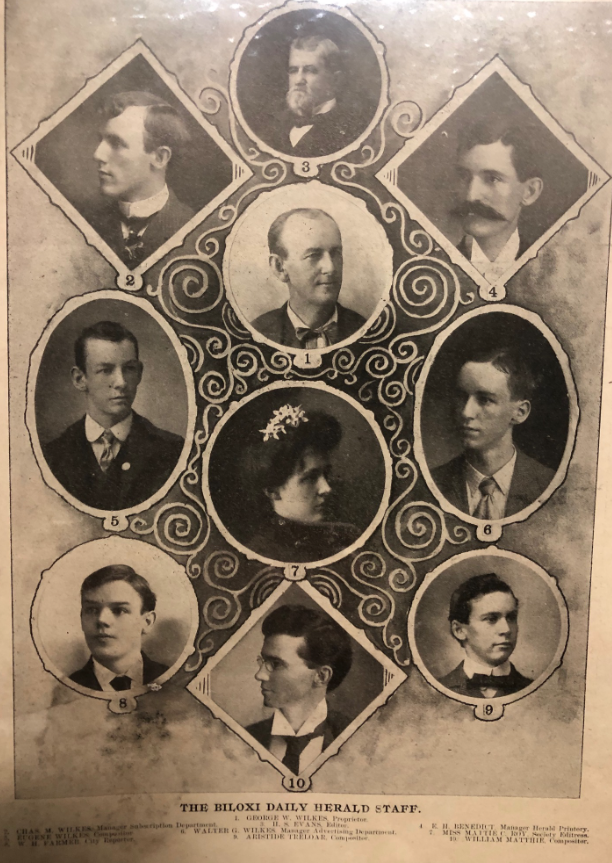
Twentieth Century Coast Edition of the Biloxi Daily Herald: Historical and Biographical(George W. Wilkes & Sons: Biloxi-1902).
H.S. Evans, editor and E.H. Benedict, manager of the Herald Printery.
The Daily Herald
Editor George P. Money
George Pierson Money (1867-1951), the elder brother of H.D. Money, was born in Hinds County, Mississippi. Like his brother, George P. Money was a lawyer having studied for the bar examination in Carrollton, Mississippi. In 1891, he was admitted to the bar there and practiced law for twenty-five years. When his father was in the Senate, young Money resided in Washington D.C. and worked as a file clerk in the House of Representatives document room and was chief clerk in the folding room of the House of Representatives. He also worked on a USGS survey team, which was mapping the region near the District of Columbia.(The Daily Herald, March 7, 1951, p. 1)
George P. Money’s law experience was quite varied. From 1893 to 1900, he worked as the assistant U.S. attorney for the Territory of New Mexico. In November 1904, he ran unsuccessfully as a Democrat for the position of delegate to Congress from the New Mexico Territory. In 1905, the G.P. Money family relocated to the Mississippi Gulf Coast. He was the deputy clerk and U.S. commissioner at Biloxi from 1918 until 1949.(The Daily Herald, June 3, 1948, p. 6 and March 7, 1951, p. 1)
At heart, George P. Money was a newspaperman. His early experience was with The Chattanooga Evening News and The Greenwood Enterprise, where he co-published with Governor James K. Vardaman (1861-1930). During WW I, Money became associated with The Daily Herald. He was with this journal for thirty-two years and was its longtime editor.(ibid.)
REFERENCES:
The Biloxi Daily Herald, Business and Professional Men, (The Biloxi Daily Herald: Biloxi, Mississippi-1902), p. .
The Daily Herald 50th Golden Jubilee Number Biographical and Historical 1884-1934, (The Daily Herald: Gulfport-Biloxi, Mississippi-1934).
Charles L. Dyer, Along The Gulf, (Women of the Trinity Episcopal Church: Pass Christian-1971. Originally published in 1895).
T.H. Glenn, The Mexican Gulf Coast on Mobile Bay & Mississippi Sound Illustrated, (Graham-Delchamps: Mobile, Alabama-1893).
Journals
The Biloxi Herald, “Removal”, April 4, 1891.
The Biloxi Herald, “A statement”, December 12, 1896.
The Biloxi Daily Herald, “Captain J.H. Miller acquitted”, July 10, 1897.
The Biloxi Daily Herald, “Result of unfortunate newspaper controversy”, July 10, 1897.
The Biloxi Daily Herald, “Unwarranted insinuation”, November 21, 1896.
The Biloxi Daily Herald, “Recorder’s Court”, December 12, 1896.
The Biloxi Daily Herald, “A statement”, December 12, 1896.
The Biloxi Daily Herald, “Not Guilty”, July 3, 1897.
The Biloxi Daily Herald, “Captain J.H. Miller acquitted”, July 10, 1897.
The Biloxi Daily Herald, “City News”, March 3, 1903.
The Daily Herald, ‘The Daily Herald will make improvement’, August 24, 1911.
The Daily Herald, “George Washington Wilkes”, March 30, 1915.
The Daily Herald, “Funeral of G. W. Wilkes conducted from late Howard Avenue residence”, March 30, 1915.
The Daily Herald, “Tribute to memory of G. W. Wilkes by editor of “The Coast Advertiser”, March 30, 1915.
The Daily Herald, ‘Diamond Jubilee’, October 3, 1959.
The Daily Herald, ‘Announce sale of The Daily Herald’, July 10, 1968.
The Daily Herald, ‘The Daily Herald nears century of service’, June 3, 1973.
The Daily Herald, ‘Herald celebrates 89th anniversary’, October 15, 1973.
The Pascagoula Democrat-Star, ‘Personal’, October18, 1878.
The Pascagoula Democrat-Star, ‘A Change’, September 30, 1881.
_________________________________________________
1893
The Biloxi Blizzard
Louis Rosenthal (1851-1942), an 1853 Prussian immigrant, commenced The Biloxi Blizzard in February 1893. From comments about his newspaper, it appears that it’s early months were difficult and there were times when The Biloxi Blizzard was not published. The Biloxi Herald, a competitor, wrote in April 1894, that “after a suspension of several months, The Biloxi Blizzard made an appearance on April 1st. L. Rosenthal appears on the masthead as editor and proprietor
The Biloxi Blizzard advertised in 1893 as follows:
THE BLIZZARD
Published every Wednesday by the Biloxi Publishing Company
Louis Rosenthal, Editor and Manager
Subscription $1.50 per year
(T.H. Glenn, 1893, advertisement)
Family
Louis Rosenthal married Brunette Levy (1868-1956) at New Orleans on February 19, 1888. They were the parents of seven children and six sons survived to adulthood: Seligman T. Rosenthal (1889-1973); Leon Rosenthal (1890-1920+) m. Fannie Heymann; Aaron Rosenthal (1893-1917+); Jacob Rosenthal (1895-1972); Marcus Rosenthal (1902-1970); and Ezra Rosenthal (1904-1994)
The Mandeville Wave
The Rosenthal family left Biloxi for Mandeville, Louisiana before 1900. Here Louis found employment with The Mandeville Wave, a small journal, as a journalist.
REFERENCES:
Charles L. Dyer, Along The Gulf, (Women of the Trinity Episcopal Church: Pass Christian-1971. Originally published in 1895).
T.H. Glenn, The Mexican Gulf Coast on Mobile Bay & Mississippi Sound Illustrated, (Graham-Delchamps: Mobile, Alabama-1893).
The Biloxi Herald, “Local Happenings”, February 4, 1893.
The Biloxi Herald, “Local Happenings”, April 7, 1894.
The Biloxi Herald, “Local Happenings”, May 25, 1895.
The Biloxi Herald, “Local Happenings”
The Biloxi Daily Herald, “City News”, March 3, 1903.
_______________________________________
1895
The Biloxi Banner

Biloxi Banner
[fo Along The Gulf, Dyer, 1895]

[The Biloxi Herald, March 16, 1895, p. 1]
William Edward Champlin [1866-1911]
W.E. Champlin married Rosa A. Leger in November 1891.
The Biloxi Banner was founded by W.E. Champlin on March 9, 1895. Mr. Champlin was born at Handsboro, Mississippi to Lewis Champlin and Sarah
Died June 23, 1911.
REFERENCES:
The Clarion Ledger [Jackson], 'Orange Bloosoms', November 7, 1889, p. 8.
The Biloxi Herald, 'Biloxi Banner', March 16, 1895, p. 1.
The Daily Herald, 'Biloxi Banner', June 27, 1911, p. 4.
______________________________________
1896
The Biloxi Review
The Biloxi Review published it first weekly newspaper on July 25, 1896. It was commenced by H.S. Evans.
H.S. Evans
H.S. Evans had relocated to Gulfport by August 1897 and had taken the reins of The Gulfport Southward. It had shown improvement under his managing skills.(The Biloxi Daily Herald, August 7, 1897 p. 1)
Joseph D. McKie
Joseph D. McKie (1858-1907) bought the Biloxi Review circa 1906. He was born in Tennessee. J.D. McKie and family arrived at Biloxi circa 1895, probably from Birmingham, Alabama. He had married Lura McKie (1859-1919+), also a Tennessee native, who bore him two daughters, Laura J. ‘Nita’ McKie, Mississippi native, and Ernestine McKie (1881-1919), born Alabama. Before his career as a publisher, J.D. McKie had been a druggist and have practiced his trade at New Orleans and Birmingham.(The Biloxi Daily Herald, November 5, 1907, p. 2)
Biloxi
At Biloxi, the McKie family was domiciled at 627 East Howard Avenue on the corner of Keller Avenue. The Biloxi Review was moved to Gulfport and called the Gulfport Review. The McKie women were quite industrious as Lura McKie worked as a reporter; Nita McKie was a stenographer for a naval stores company; and Ernestine McKie kept books.(1910 Harrison Co., Mississippi Federal Census T624_740, p. 9A, ED 33)
Demise
Joseph D. McKie expired at Biloxi, Mississippi in early November 1907. He was a personal friend of James K. Vardaman (1861-1930), Mississippi governor from 1904 to 1908. The body of J.D. McKie was interred in the Biloxi Cemetery. When a Woodmen of the World monument was placed on J.D. McKie’s grave in late February 1908, former Governor Vardaman gave a speech.(The Biloxi Daily Herald, February 29, 1908, p. 4)
Nita McKie developed an illness, possibly tuberculosis, which resulted in the family relocating to Del Rio, Texas. Lura McKie sold the family home to Joseph Comber, Biloxi merchant, for $2600 in December 1912. Nita died at Del Rio, Texas in December 1919. Her corporal remains were sent to Biloxi for burial near her father.(The Daily Herald, December7, 1912, p. 4 and February 4, 1919, p. 3)
REFERENCES:
Twentieth Century Coast Edition of the Biloxi Daily Herald: Historical and Biographical(George W. Wilkes & Sons: Biloxi-1902), see page 48.
The Biloxi Herald,“City News”, August 1, 1896.
The Biloxi Herald,“Biloxi Review and Ocean Wave”, October 24, 1896.
The Biloxi Herald, “A heavy suit for libel”, September 12, 1896.
The Biloxi Herald,“An open letter”, September 26, 1896.[W.F. Gray, editor’s reply to Sivad [Davis] of the OS Wave]
The Biloxi Daily Herald, “Necrology”, November 5, 1907.
The Biloxi Daily Herald, “City News”, February 29, 1908.
The Daily Herald, “Several sales of Biloxi property”, December 7, 1912.
The Daily Herald, “Miss Nita McKie dead”, February 4, 1919.
_____________________________________________________________
1939
The Gulf Coast Examiner
The Gulf Coast Examiner, a weekly journal "dedicated to Good Government" and published by the Gulf Coast Publishing Company and located at Lameuse and Washington Streets, published its first issue on June 15th. E.J. Hosch, formerly assistant publicity director at Mississippi State College was editor and publisher. Edward Brumfield, formerly of the Mississippi Guide, was advertising manager and superintendent of the mechanical engineering department. Other employees were: Virgil England, fomerly with the Miami, Oklahoma Daily News Record; Samuel Wells; Clyde Campbell; and Mrs. E.J. Hosch.(The Daily Herald, June 15, 1939, p. 3)
REFERENCES:
The Daily Herald, ‘New weekly to be published at Biloxi’, June 15, 1939, p. 3)
- 4340 views